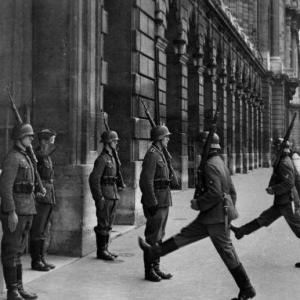The Capetian dynasty began with Hugues Capet. It gave thirty seven kings to France and reigned from 987 to 1328. It was to have consequences up to the 19th century, with its collateral branches, the Valois and the Bourbons. The fates of the Basilica of Saint-Denis and the Capetian dynasty are intertwined. The Capetians played a key role in the advent of the royal necropolis in Saint-Denis.
The Basilica Cathedral of Saint-Denis aroused, over the centuries, passion, acceptance and denial based on the whims of the Royal and Political natures at that time. The Carolingians and Merovingians neglected Saint-Denis for nearly a century. Defenders of Paris against Viking invasions, notably king Eudes, understood the political and spiritual role which could be played by the Abbey in their strategy to gain power. Once again, Saint-Denis was associated with a change of dynasty. From Hugues Capet in 996, the decision was taken to be buried in Saint-Denis.
In the 12th century, the Abbot Suger, adviser to Louis VI and Louis VII and, as Richelieu said, « father of monarchy » confirmed the important role of the necropolis of the Basilica. For historians, royal sepultures « inherit the natural right to be in the Church of Saint-Denis. » Monks did not hesitate to produce false documents to support this thesis such as the false contribution by Charlemagne (813). The document stipulated that Charlemagne, to express his gratitude for the victories won over the pagans, gave France as fief to Saint-Denis where the king henceforth had to be crowned. It is even said that his crown must be deposited on the altar of the Martyrs by offering four gold bezant plates to show that he received the kingdom in inheritance by God and the Saints.
The kings who succeeded him gradually fulfilled this expectation. Links between the abbey and the monarchy were still developing when Louis VI acknowledged a true « rights of the remains » confirmed in the 12th century. Monks become the unique custodians of the Regalia, which was till then kept in the Treasury of the Abbey and brought solemnly by the Abbot of Saint-Denis to Reims, the day of the coronation.
The Capetians are behind the famous « Montjoie Saint Denis » their rallying cry on the battlefield destined to receive the protection of their patron Saint, Saint Denis, who dethroned Saint Martin.
This fierce determination to appropriate the bodies of kings culminated in the time of Saint Louis who reserved the necropolis only for kings or queens who had been on the throne. No exception was made for the royal children who were buried at the Abbey of Royaumont. The Order of Saint Louis, erected in the center of the Basilica in the 12th century, embodied the will that the abbey become the « graveyard for kings » in the terminology of a medieval chronicler.
At that time, nothing or almost nothing distinguished the kings tombs. Also, the abbey monks planned to create retrospective tombs in order to cultivate the royal memory.
The objective of Saint Louis was political. He wanted to portray the Capetian dynasty that he represented, as the natural heir of the Merovingians and Carolingians. The arrangement of the tombs enables visitors to view the three royal dynasties. In 1254, Vincent de Beauvais affirmed that Louis VIII, the father of St. Louis, was a descendant of the Emperor Charlemagne through his mother Isabelle Hainaut. In quest of legitimacy, the Capetians, whose dynasty was born out of a misuse of title, attempted to associate themselves with Charlemagne, buried in Aix La Chapelle, through some Carolingian tombs in Saint-Denis. This interpretation of history was also published in texts produced in the abbey and whose library was one of the most important of the realm.
Several Capetian tombs and recumbent statues can be visited in the Basilica Cathedral. For example, Philippe III the bold, Isabella d'Aragon, Marie de brine and Philippe X le Hutin. Discover the complete list of the Carolingian kingdom.
